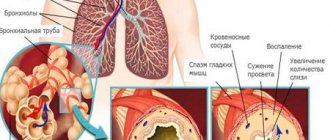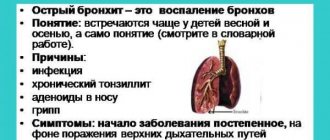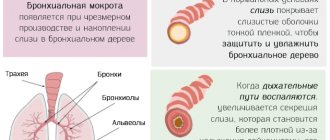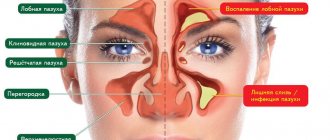Author's rating
Author of the article
Green Elena Stanislavovna
Otolaryngologist of the second category
Articles written
665
about the author
Pain is an extremely debilitating and highly subjective symptom. The patient may complain that his lungs or bronchi hurt when he coughs. But these organs lack pain receptors, so they cannot cause pain. To see this, just open a school anatomy textbook. It turns out that the patient is deceiving the doctor? Not so simple.
Causes of pain
There are many causes of cough; the cough process is always associated with breathing. This is a sharp exhalation through the mouth, as a result of which the respiratory organs are freed from foreign accumulations. A person mistakes pain in the chest area for pain in the bronchi when coughing. What exactly hurts?
Symptoms of chest pain may include:
- Associated with bronchopulmonary diseases.
- Not associated with respiratory pathology.
The bronchi are located inside the lung tissue, the lungs are “wrapped” with pleura - a serous membrane with many nerve endings. The heart “hides” behind the lungs; it also “knows how” to experience pain. The ribs, spine and sternum “protect” the chest cavity from the outside, the diaphragm from below. And they can be a source of pain. Adjacent to the diaphragm on the abdominal side is the peritoneum, which can “boast” no less number of nerve receptors than the pleura.
There is a feeling that when you cough, the bronchi or lungs hurt when:
- damage to the pleura and interpleural ligament;
- disturbances in the functioning of the diaphragm;
- diseases of the heart and pericardium;
- diseases, injuries of the ribs and spine;
- lesions of intrathoracic lymph nodes;
- pathologies of the stomach, liver, kidneys, gall bladder.
A person is sincerely convinced that his bronchi hurt when he coughs, but the “culprit” turns out to be a completely different organ. Sometimes there is a situation where there is chest pain without coughing, but it is associated with pathology of the bronchopulmonary system.
How to treat pain in the bronchi
The treatment method directly depends on the etiology of the diagnosed disease. Each of them has specific treatment tactics.
Therefore, taking medications on your own before making a correct diagnosis will not provide adequate improvement and will not contribute to a speedy recovery.
After receiving the research results and confirming the preliminary diagnosis, the doctor can make appointments.
If chest pain, manifested by bronchitis, pneumonia, tracheitis, is provoked by viruses, symptomatic therapy is prescribed. To stabilize body temperature during hyperthermia, antipyretics based on ibuprofen, paracetamol or a combination of the above active ingredients are prescribed. If they are ineffective, injection of the lytic mixture is allowed. It is equally important to get rid of symptoms such as a runny nose by rinsing the nose and then using vasoconstrictors to relieve congestion.
Immunomodulating drugs are designed to help the immune system. They are prescribed during the acute period of the disease and are aimed at stimulating the weakened body to produce interferon. The Russian market offers a huge number of similar tablets aimed at consumers with different financial capabilities.
The presence of a bacterial infection is always the basis for undergoing antibacterial therapy in tablet or injection form.
Not only laboratory tests indicate the presence of bacteria.
The presence of pus impurities, indicated by the green or yellow-green color of the secretion, confirms the presence of damage by pathogenic single-celled microorganisms. Only the attending physician can provide specifics regarding the name of the antibiotic. our article will provide an opportunity
An annoying cough reflex without mucus secretion, which brings maximum suffering to a person, is stopped by taking medications based on codeine and butamirate. Their use should be stopped immediately after the appearance of sputum.
A productive cough with lesions of the respiratory system requires dilution of secretions and their subsequent cleansing. This effect is achieved through the use of expectorants.
An equally important component of therapy for respiratory infections is inhalation with medications selected for a specific situation by a therapist or pulmonologist.
Treatment of oncological and benign neoplasms should be carried out exclusively by a specialized specialist (oncologist, thoracic surgeon).
If your bronchi hurt due to various coughs, you should not limit yourself to taking medications. There are a number of ways to alleviate the condition at home, available to everyone:
- Drinking plenty of fluids
helps remove toxins from the body and thin out thick secretions. Useful in this case are rosehip decoction, rich in vitamin C, teas from linden blossom, chamomile, thyme, fruits and raspberry shoots. - Steam inhalations using soda
, essential oils, decoctions of medicinal herbs - calendula, chamomile will soften your breath. The procedure should be carried out using a special device - a nebulizer or by filling a container with the necessary solution, over which it will be comfortable to breathe. It is recommended to cover your head with a thick cloth or towel. - A flatbread made from warm potatoes
with butter will help moderate cough attacks. Boil the potatoes in their skins, mash them slightly, adding a piece of butter and a couple of drops of iodine. Be sure to cool the mixture to avoid burns on the body and apply it to the chest, covering it with a plastic bag and securing it with a bandage. The compress can only be used at normal body temperature. - Avoid exposure to excessively cold air
and tobacco smoke. - Various herbal infusions with a mucolytic effect
, infused in a thermos for at least an hour, cope perfectly with the problem of difficult-to-discharge discharge. It is acceptable to brew sage, elderberry, plantain, tricolor violet, and anise fruit. Contraindications to the use of the infusion are pregnancy and lactation, as well as a tendency to allergic reactions.
Bronchitis is a disease of the bronchi, accompanied by an inflammatory process of the mucous membrane. Most often, bronchitis causes a cough, usually dry, difficult to treat. But can your back hurt with bronchitis?
Reasons for the development of bronchitis
Bronchitis itself is extremely rare and is usually the result of a viral or bacterial disease, but there may be other causes:
- viral infections - influenza, ARVI, whooping cough, adenovirus;
- bacterial infections - pneumococci, staphylococci, streptococci;
- external factors - hypothermia, climatic conditions, allergens, chemical toxins.
Does your back hurt with bronchitis?
There are many nerve endings on the surface of the bronchial tree, so often when coughing a person feels back pain in the chest area. This happens due to muscle contraction, especially during a severe, debilitating cough. In addition, the spine may respond to back pain.
When a person coughs, not only the pectoral muscles contract, but also the abdominal and intercostal muscles. All these contractions put pressure on the nerve processes of the thoracic and lumbar spine, which causes back pain.
Usually, at the beginning of the disease, the cough is more intense, the reason is the increased viscosity of sputum, which is difficult to separate and exit from the bronchi. The muscles constantly contract, which ultimately causes pain in the back, especially in the chest area.
There may be other reasons. Back pain with bronchitis may indicate the development of other diseases or complications:
- respiratory diseases;
- nervous system disorders;
- diseases of the urinary system;
- circulatory disorders;
- diseases of the spine.
Pain may not be caused by bronchitis itself, but by the cough that accompanies the disease. Atypical pneumonia occurs with virtually no symptoms; without timely treatment, it can develop into pleurisy and back pain will appear, which will be felt when coughing or moving. In this case, bronchitis will have a chronic form.
Does your back hurt with bronchitis?
Osteochondrosis develops latently for a long time, and pain in the spine can manifest itself during bronchitis, during coughing. The same can be said about intercostal neuralgia, polymyositis or pericarditis.
Therefore, if your back hurts due to bronchitis, you need to consult a doctor to diagnose and find out the cause of this pain.
Associated symptoms
The disease is characterized by many symptoms. The disease affects the entire body, not just a separate organ. To diagnose what exactly hurt, it is important to describe the pain in detail:
- its intensity;
- character;
- localization;
- constant or periodic;
- when it first appeared;
- stops after coughing attacks or not.
An elevated body temperature indicates an inflammatory process in the body. “Accompanies” carditis and pericarditis, myositis, pleurisy, bronchitis and pneumonia. Acute bronchitis does not hurt, but can be complicated by pneumonia. Pleuropneumonia (if the inflamed lung tissue is adjacent to the serous membrane) is characterized by pain.
Often the “point of application” of pain is the interpleural ligament. With intense coughing, it constantly stretches. Additional symptoms are attacks of shortness of breath in bronchial asthma and cough recurrences in whooping cough.
Diagnostics
Pain is considered a subjective (individual) symptom. No matter how detailed and accurately a person describes the symptoms, neither a doctor nor another, even a very close relative, will be able to feel his pain. Various pain scales have been developed and used in medicine. They are based on the patient's own description of pain by answering specific questions. Evaluating the questionnaire helps determine the nature of the pain and methods of dealing with it. Carrying out differential diagnosis is impossible without additional examination.
The doctor may need the following information:
- A general blood test will show the presence of an inflammatory process;
- A general urine test will help exclude diseases of the excretory system;
- bacteriological methods will establish the source of the pathogen;
- X-ray examination will confirm or refute the pathology;
- electrocardiography will help in diagnosing circulatory diseases;
- the functional state of the respiratory system will be revealed by the spirometry method;
- Ultrasound examination of the chest organs will reveal pathology of the heart and pleura;
- bronchoscopy will make it possible to examine the condition of the bronchi from the inside;
- consultations with medical specialists will help determine the diagnosis and treatment methods.
It would not be surprising if, if you have chest pain, your doctor will refer you for an X-ray of the spine or an ultrasound of the abdominal organs. Do not be alarmed if you need to consult an oncologist or phthisiatrician. It is extremely important to find the cause of the pain and promptly prescribe adequate treatment.
What to do if your bronchi hurt
It is immediately worth noting that the appearance of such symptoms is not a reason to panic, but at the same time, such a condition should not be left to chance, because it poses a real danger and threat to human life and health.
Therefore, we advise you to contact a qualified specialist as soon as possible to undergo an examination and prescribe laboratory and instrumental diagnostic methods applicable in a particular case.
When visiting a doctor, it is extremely important to note any bothersome symptoms. First of all, describe the nature of the pain: aching, stabbing, occurring in attacks. It is equally important to note their localization, possible relief or, on the contrary, worsening during physical activity, deep inhalations and exhalations.
To compile a clinical picture, it is necessary to indicate disturbing concomitant signs of the disease, such as increased body temperature, the presence or absence of a dry, wet cough. Thus, the doctor will be able to draw preliminary conclusions, which will have to be confirmed or refuted through research.
It is especially important to establish a diagnosis and begin treatment for a child as soon as possible, because in infancy and preschool age there is a high chance of developing obstruction due to bronchitis, in the absence of adequate therapy. We talked about what sputum can be like with bronchitis in our article.
Treatment
The body reacts to pain with functional changes - dilation of the pupils, fluctuations in blood pressure, pulse, sleep disturbances, and lack of appetite. With severe pain, including pain in the chest area, pain shock may develop. You should never endure pain or try to cope on your own.
Painful symptoms are treated symptomatically. The patient is prescribed painkillers. Most often, if there are complaints of pain in the bronchi when coughing, back pain when coughing, pain in the chest if there is no cough, the use of analgesics is necessary to normalize the patient’s condition and prevent complications. Even the most harmless and widely advertised drug has contraindications, side effects, and can cause a worsening of the disease.
Relieving pain does not eliminate the causes of its occurrence. Chest pain often goes away with treatment of the underlying disease. Therefore, the main emphasis is on etiotropic therapy - aimed at combating the source of pathology.
Pain after quitting smoking
Quite often, the bronchi hurt in those people who decide to get rid of a bad habit. Why does quitting smoking lead to such consequences?
The fact is that as soon as a heavy smoker decides to get rid of a bad habit, the body begins to actively restore the functioning of all organs and systems. First of all, the respiratory organs begin to rapidly cleanse themselves.
In a smoker, the bronchi are clogged with tars and carcinogenic substances. The epithelium is thinned and irritated. The process of restoring the functioning of the respiratory organs may take several weeks, while the patient will feel pain in the chest.
In addition to chest pain, recovery may be accompanied by the following unpleasant symptoms:
- Dry mouth.
- Shortness of breath.
- Cough, with copious sputum production.
- Weakness and irritability.
Usually, the discomfort associated with quitting smoking goes away after 3-4 weeks without any consequences.
During the period of recovery of the respiratory organs, a person’s immunity decreases, so he becomes vulnerable to various infectious diseases.
Application of traditional methods
The opinion that traditional methods of treatment are safe is extremely erroneous. If the reference book on alternative medicine contains recommendations for the treatment of pain in the bronchi, the first thing to do is to immediately return the reference book to waste paper. Competent healers know very well that the bronchi do not hurt. Competent doctors do not deny herbal medicine and “grandmother’s” advice. The methods of traditional and official medicine in combination can complement each other.
Adequate manuals on alternative medicine and herbal medicine will contain advice on the treatment of bronchitis, pleurisy, pneumonia, osteochondrosis, cough relief, detoxification methods, combating hyperthermia, relieving edema, and improving sputum discharge.
Compresses made from boiled potatoes, honey, and garlic are relatively safe procedures. The main contraindications to their implementation are skin lesions and hyperthermia. When rubbing with badger fat, you should think about when the patient will be able to take a hygienic bath? Fat “clogs” the sebaceous and sweat glands and can cause deterioration.
Inhalations and aromatherapy are popular. If the patient does not have allergies, the method is quite effective. When using medicinal plants, it is imperative to ask where and how the herbs were collected, dried, and stored in order to avoid toxic chemicals and radionuclides from entering the body.
In children prone to acetone syndrome and allergies, the use of “grandmother’s” advice should be treated with special caution. The attending physician will help determine the need to use one or another method and warn against the development of complications.









